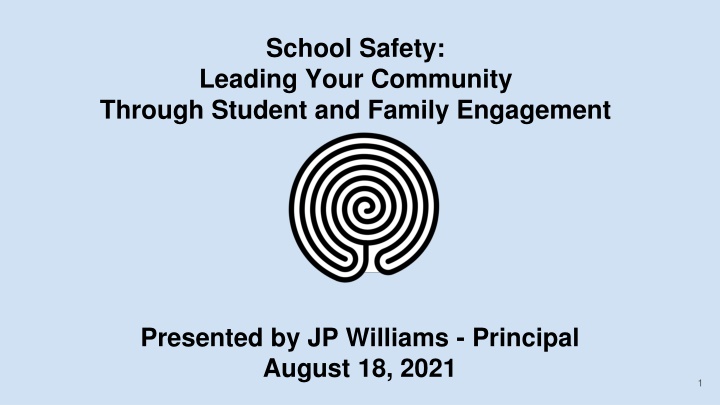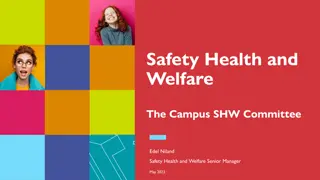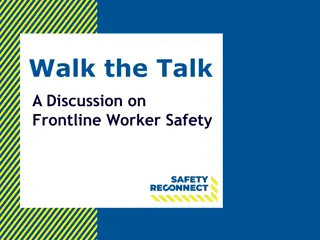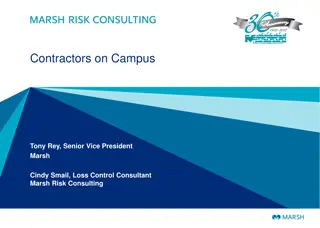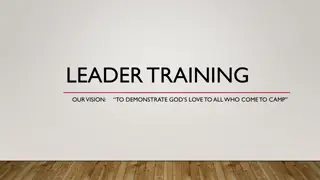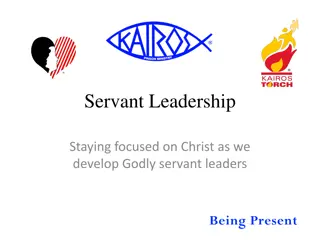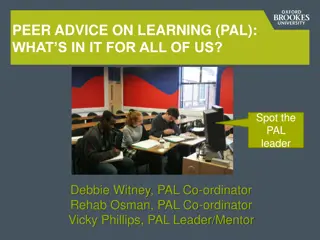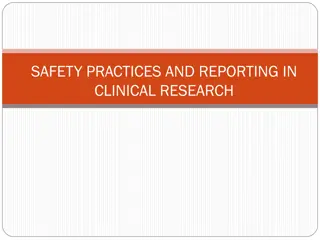Essential School Safety Strategies for Leaders
Dive into crucial school safety terms, emergency protocols, and proactive measures for leaders in the educational community. Learn about lockdown procedures, social media monitoring, emergency action plans, and more to ensure a secure educational environment. Explore the importance of community engagement, comprehensive safety planning, and building partnerships across stakeholders.
Download Presentation

Please find below an Image/Link to download the presentation.
The content on the website is provided AS IS for your information and personal use only. It may not be sold, licensed, or shared on other websites without obtaining consent from the author.If you encounter any issues during the download, it is possible that the publisher has removed the file from their server.
You are allowed to download the files provided on this website for personal or commercial use, subject to the condition that they are used lawfully. All files are the property of their respective owners.
The content on the website is provided AS IS for your information and personal use only. It may not be sold, licensed, or shared on other websites without obtaining consent from the author.
E N D
Presentation Transcript
School Safety: Leading Your Community Through Student and Family Engagement Presented by JP Williams - Principal August 18, 2021 1
Table of Contents Slide 3: Breakout Session Objectives Slide 4: School Safety Terms and Definitions Leaders Must Know Slide 6: What is School Safety? Whole Group Brainstorm Session Slide 7: Mental Health and Behavioral Health Slide 9: Health and Wellness Slide 10: Physical Safety and Security Slide 11: Culture, Climate, and Community Slide 12: Leadership, Law, and Policy Slide 13: Operations and Emergency Management Slide 14: Safe and Supportive Schools Model Slide 18: Actively Engaging Families... Slide 19: Create and Implementing a Framework Slide 21: Creating An Action Plan Slide 26: Key Elements of Student and Family Engagement Slide 28: Additional Resources Slide 29: Additional Articles and References 2
Breakout Session Objectives Introduction to new ideas and strategies for expanding your understanding of School Safety Help Leaders begin constructing ideas and plans to address school safety with a comprehensive approach Support educators with resources and information to take a serious approach to comprehensive school safety. Major Takeaways 1. Engage your community 2. Plan for school safety 3. Prepare ahead of time 4. Build community-wide partnerships with all stakeholders 3
School Safety Terms and Definitions Leaders Must Know Lockdown - an emergency protocol which prevents students, teachers, or staff from leaving or entering an area School-Site Protection Systems - alerts students, teachers and staff as well as first responders and protect those in the school from attack Social Media Monitoring - scans for problems or threats online, especially since the majority of bullying incidents now occur in the digital sphere Emergency Action Plan (EAP) - An effective EAP includes A preferred method for reporting fires and other emergencies, an evacuation policy and procedure, emergency escape procedures and route assignments (i.e., floor plans, safe areas), and contact information for, and responsibilities of individuals to be contacted under the EAP Contagion Period - a theory created by Sherry Towers of Arizona State University that posits that 30% of mass shootings with a high number of victims and national media exposure occurs within 13 days of the previous mass shooting Mass Notification System - a platform that sends one-way messages to inform students, parents, teachers, and staff of an emergency situation Learn more @ Here are the Top School Safety Terms You Should Know 4
School Safety Terms and Definitions Leaders Must Know Entry-Control Equipment - technology meant to make it easier to restrict access to school authorized users, such as electromagnetic door locks or restricted areas School Safety Task Force - a group of individuals who identify products, programs, and systems to improve school safety Alyssa s Law - a law signed into legislation in New Jersey named for Alyssa Alhadeff, who was one of the 17 people killed in the Parkland, Florida shooting, which requires public schools to install silent panic alarms that can be activated in case of an active-shooter situation Liability Quotient - a determination of a school district s exposure to liability regarding school safety, can be lowered by proper training and best practices to improve safety Shelter Directive - a safety strategy that posits stating the hazard allows for an understanding of the threat and the associated protective actions, most often utilized for tornadoes or severe weather, in which case the directive would include where students and staff should be ready to take emergency measures and shelter Multidisciplinary Approach - an approach to safety planning where administrators collaborate with school district police officers and local law enforcement as part of a risk assessment team Learn more @ Here are the Top School Safety Terms You Should Know 5
What is School Safety? Whole Group Brainstorm Session Take 3 minutes( 180 seconds) to write down all of your current ideas about what is school safety? And Go!!! Safety Challenge: Set a goal with your Safety Team to clear and evacuate your school within 180 seconds (3 minutes) or less during a fire drill. Keep track of your best times and partner with your local FD & PD to get suggestions for safe evacuations. https://www.safeandsoundschools.org/ 6
Mental Health and Behavioral Health Engage families in mental and behavioral health interventions Ensure engagement begins at the initial contact with the family Recognize and respond to the perceptions of parents and families regarding their barriers to treatment Enlist parents and guardians in developing service-delivery strategies Utilize evidence-based programs when developing interventions Include education, assistance, and support to help families Suicide Prevention and Support must be included in your plan Question: Does your school/district have a written suicide prevention and remediation plan? Check out the Montana Law regarding training requirments for educators pertaining to Suicide Training and Prevention: House Bill 381 Training Guidance Question: If you are not based in Montana; Where can you find laws regarding Suicide Training and Guidance for your school community? Action: Look up your governance legislation for guidance and share the info with your School Safety Team. 7
Mental Health and Behavioral Health In Montana If you or someone you know are in crisis, please call the Montana Suicide Prevention Lifeline 24/7 1-800-273-Talk (1-800-273-8255). Or, use the Crisis Text Line, text MT to 741-741. OPI Staff are here to help: Tammy Lysons, SSAE Title IV-A Program Manager - 406.431.2309 Holly Mook, Coordinated School Health Unit Director - 406.431.3126 8
Health and Wellness T/F: Physical safety is related to higher academic performance, fewer risky behaviors, and lower dropout rates. T/F: Students who feel safe are more likely to stay in school and achieve academically. T/F: Students who are not fearful or worried about their safety feel more connected to their school and care more about their educational experience. Question: Does your school/district have a comprehensive mental health program available to students and families? Answer: Take a few minutes to briefly describe your school/district program with your group. 9
Physical Safety and Security Physical safety refers to the protection of all stakeholders, including families, caregivers, students, school staff, and the community, from violence, theft, and exposure to weapons and threats, in order to establish a secure learning environment. Homework Question: What are your school/ District/ Community policies for Physical Safety and Security? Homework Question: Where can you find this information out about your organization? 10
Culture, Climate, and Community Every School and District needs an engagement plan with clear objectives and definable, measurable leadership actions. Your plan needs to include: A written Continuous School Improvement Plan (CSIP) Engaging Stakeholders in School Climate Improvements Collecting and reporting School Climate Data Implementing and conducting focus groups and interviews with students, staff, or families Choosing and Implementing School Climate Interventions Monitoring and Evaluating Overall School Climate Improvements School climate improvement produces benefits for all students. Students are more likely to engage in school and develop positive relationships when schools participate in an intentional effort to improve and sustain school climate. Similarly, students are more likely to feel safe, nurtured, and welcome and are less likely to exhibit problem behavior, in and out of school. You can learn at this link: Reference Manual on Making School Climate Improvements Question: In what ways have you already been successful in community engagement that lends to a positive climate and school culture in your setting? (Discuss it) 11
Leadership, Law, and Policy Question: Are you familiar with or currently implementing practices centered around the following legislation: DREAM Act (S. 1615/H.R. 3440) Eagles Act (S. 2759) Fix NICS Act (S. 2135/H.R. 4477) Handle with Care Act (S. 2754) Mental Health in Schools Act (H.R. 2913/S. 1370) Protecting Student Athletes from Concussions Act (H.R. 3580) Safe Schools Improvement Act (H.R. 1957/S. 2572) STOP School Violence Act (H.R. 4904/S. 2495) Action: Write down 2-3 current and state and federal laws your are familiar with that impact school safety in your community? 12
Operations and Emergency Management It is critical for schools/institutions of higher education and communities to work together to develop plans that can be effectively implemented in the event of an emergency. Engagement. Strong relationships between students, teachers, families, and schools and strong connections between schools and the broader community. Safety. Schools and school-related activities where students are safe from violence, bullying, harassment, and controlled-substance use. Environment. Appropriate facilities, well-managed classrooms, available school-based health supports, and a clear, fair disciplinary policy. 13
Safe and Supportive Schools Model What does your school/district Emergency Management Plan (EMP) flow chart look like? (Pair & Share) What action can you take to develop or refine your EMP and who will be involved in the process? (Brainstorm) 14
Actively Engaging Families in Creating Safe Environments Take Action It is imperative that families are actively engaged in creating safe and supportive schools for students. Leaders need to develop resources for parents and partners to implement effective and successful school safety programs. Leaders should: Lead parents and school communities in having conversations with their School Leaders and leadership stakeholders about: School safety policies and procedures Introduce preventative resources for students, families, and school personnel Facilitate what type of communication channels are actively in place for families and students. Question: What are 2 critical actions you are considering today for taking leadership actions in engaging Families??? 15
Actively Engaging Families... Mobilizing Family Stakeholders with resources to get in the know about school safety, host a school safety forum and advocate to decision makers about school safety. Take Action Leaders should: Develop a comprehensive school safety program with the goal of improving safety and security by mobilizing parents, school administrators, elected officials, policymakers, and students to take action on the issue of school safety and security. Educates individuals on the elements of school safety Engage school administrators, parents, students, law enforcement, and other community members in making the school safer Facilitates the development of strategic plans 16
Time for some action A critical action model is creating a comprehensive approach to school safety that addresses school safety problems that may be promoting an unsafe school environment. In a small group brainstorm your ideas and lead a discussion on the following: Take Action Leaders Should: Take a few minutes to develop a graphic organizer your model based on each action below. Write down your ideas and continue to refine and develop them over time. Form an action team - Who will this be in your district /building? Identify safety and security problems - What are some major obstacles that require action? Hold a school safety and security forum - When will you hold the forum? Who is invited? Develop an action plan for your plan? - What goals and objectives will you develop Publicize your initiative communicate the plan? - Which media forums will you use to Advocate for your cause - How are you achieving community buy in? Evaluate success and revise the plan - How often will you evaluate and update your plan? 17
Actively Engaging Families... Mobilizing for Change: Focuses on action what can school leaders, family members, and community partners do to ensure that schools are safe and supportive places for our children to learn. Two lessons from Sandy Hook. Take Action Leaders Should: Watch and share the following videos to learn more about about creating change in your community. School Safety: Mobilizing for Change - WEBINAR PrepTalks: Michelle Gay "Rethinking School Safety" 18
Create and Implementing a Framework Integration of Services and Initiatives Provide ongoing, high quality, relevant, and job embedded professional development to all school staff. Encourage the use of professional learning communities or other structured avenues to foster collaboration among school staff. Ensure that district and school building teams have representation of diverse stakeholders, including principals, teachers (general and special education), parents, school security professionals and school resource officers (SROs), school-employed mental health professionals (e.g., school psychologists), and other specialized instructional support personnel. Engage in resource mapping to better understand available resources and how they are utilized through the school or district to support: - Instruction, Organization, and management - Learning supports (e.g., mental and behavioral health services) 19
Creating and Implementing a Framework Take Action Leaders should: Begin development of a plan by assessing the organizational strengths and weaknesses in regard to school safety Homework: Take the survey and develop your framework Assessing the Safety of the School Environment Using the Framework This tool helps to assess the policies and practices represented in the framework, identify effective systems that need sustained effort, and components in need of change to better support school and student physical and psychological safety. Survey Available @ https://www.nasponline.org/ 20
Creating and Implementing a Framework Action Steps for Implementing a Framework Take Action Leaders Should: Implement Building-Level Policies to Improve School Safety Establish a school safety and crisis team that includes key personnel: principals, teachers, school- employed mental health professionals, school nurse, instruction/curriculum professionals, school resource/safety officer, parents, and a staff member skilled in data collection and analysis. This team should generally align with the district team in terms of structure, processes, and team member roles. Establish a multi-disciplinary team approach for regularly reviewing student data (both behavioral and academic) Allow sufficient staff time to review program and intervention effectiveness, identify areas of continued improvement, plan implementation, and receive relevant professional development. Promote positive behavior interventions and supports and other positive discipline strategies that reduce the inappropriate and disproportionate use of suspension and expulsion. Include explicit goals related to school climate and school safety in the school/district level improvement plan. Develop and implement procedures (including anonymous reporting) for students, staff, and families to report potential threats or other concerning behaviors. Use evidence-based risk and threat assessment and management protocols. Ensure transparency and engagement by communicating goals, plans, and outcomes with stakeholders. 23
Brainstorm your Framework - Leader Action Leaders Should: Develop your Framework by writing down answers to the following: Who will be on the Multidisciplinary Team? What dates will a safety review occur in my building? What are specific supports and interventions our team will develop? Name 3 specific safety goals for your school or district. What is the threat reporting procedure for my school/district? Has the school/district implemented evidence based practices for school safety? How will I as a leader create transparency and report to the school community? 24
Homework: After developing your Framework - read through the questions below and begin thinking about your action plan. Questions: What is our district vision for family engagement? How do we ensure that families, staff, and students have a voice in establishing this vision? How can we ensure communication is parent friendly and truly twoway? How is our district addressing challenges such as childcare, English-language proficiency, non- traditional work hours, and access to transportation? How can we use the cultural backgrounds of our families to enrich instruction and school climate? What might make a family feel unwelcome or uncared for at our school? How can we address this? What are we doing to actively build trusting relationships with families? 25
Key Elements of Student and Family Engagement Validating the significant role of families in planning and making decisions for their children Development of mutually agreed upon plans along with the delivery of concrete services that families view as helpful Identify and remove barriers to engaging families and students. Develop data that measures engagement activities for responsive feedback Invite families to share priorities, concerns, and feedback Offer flexibility and variety in engagement opportunities Leader Action: List 2 More elements of student and family engagement from your own experiences and share with your group. 26
You dont know what you dont know. Take Action: Start your leadership actions in August for school safety. Revisit ideas and actions on a quarterly basis or as often as necessary. Evaluate: Evaluate your school/district safety plans by August 20 Educate: Plan purposeful actions and time during your school PIR or Inservice days. Motivate: Build a strong, safety conscious team made up of all stakeholders. Include Teachers, Support Staff, Parents, Students, and Leadership Communicate: Be Transparent, express concerns and needs, invite discussion and feedback. 27
Additional Digital Resources School Safety Lexicon School Safety Professional Development Grant Emergency Planning & Safety School Safety - Family Resources REMS TA Center Website Be Safe and Sound in School Safe and Sound Schools School Safety Nonprofit, founded by Sandy Hook parents Policy Recommendations for Implementing the Framework for Safe and Successful Schools Summary of Recognized Evidence-Based Programs Implemented by Expanded School Mental Health (ESMH) Programs* Center for School Me Mental Health Module Series Physical Safety | Safe Supportive Learning School Climate and Safety Montana Suicide Awareness & Prevention Resources for Parents [READ] Family Engagement in Schools: A Comprehensive Guide 28
Additional Articles and References McNeely, C. A., Nonnemaker, J. M., & Blum, R. W. (2002). Promoting school connectedness: Evidence from the National Longitudinal Study of Adolescent Health. Journal of School Health, 72(4), 138 146. Osher, D., Dwyer, K., & Jimerson, S. R. (2006). Safe, supportive, and effective schools: Promoting school success to reduce school violence. In S. R. Jimerson & M. J. Furlong (Eds.), Handbook of school violence and school safety: From research to practice (pp. 51 72). Mahwah, NJ: Erlbaum. Ripski, M. B., & Gregory, A. (2009). Unfair, unsafe, and unwelcome: Do high school students perceptions of unfairness, hostility, and victimization in school predict engagement and achievement? Journal of School Violence, 8(4), 355 375. Stewart, E. B. (2008). School structural characteristics, student effort, peer associations, and parental involvement: The influence of school- and individual-level factors on academic achievement. Education and Urban Society, 40(2), 179 204. 29
Additional Articles and References National Center on Safe Supportive Learning Environments. (2011). Making the case for the importance of school climate and its measurement [Webinar]. Washington, DC. Retrieved from http://safesupportivelearning.ed.gov/events/webinar/ making-case-importance-school-climate-and-its- measurement MacNeil, A. J., Prater, D. L., & Busch, S. (2009). The effects of school culture and climate on student achievement. International Journal of Leadership in Education, 12(1), 73 84. U.S. Department of Education. (2014). Guiding principles: A resource guide for improving school climate and discipline. Washington, DC: Author. Retrieved from http://www2.ed.gov/policy/gen/guid/school- discipline/guiding-principles.pdf Mapp, K., & Bergman, E. (2019). Dual capacity-building framework for family-school partnerships (Version 2). Retrieved from: www.dualcapacity.org 30
